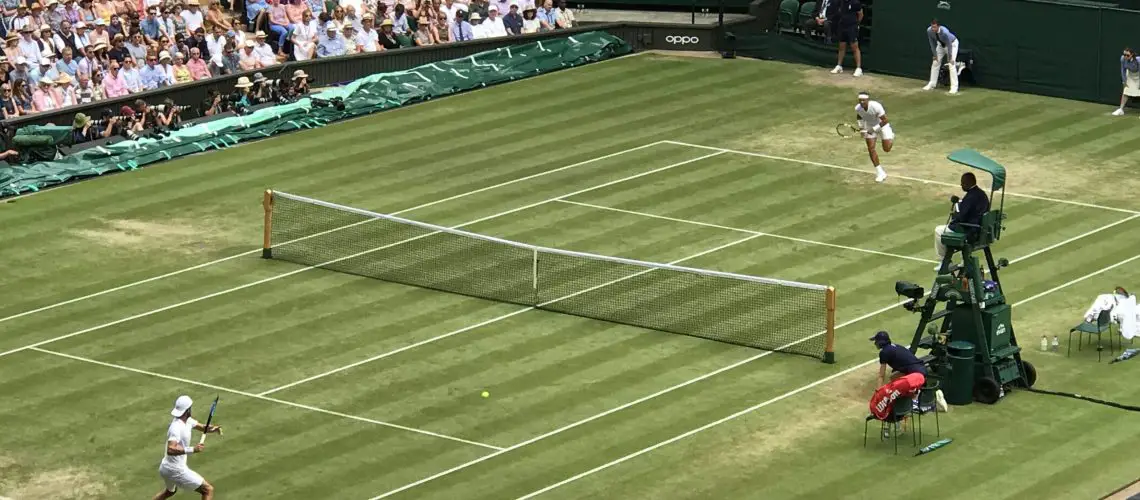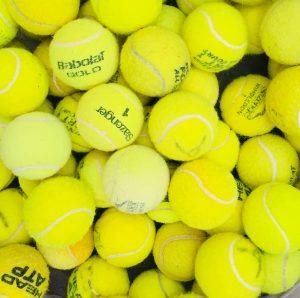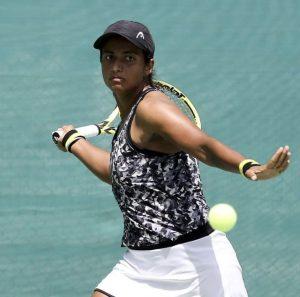We may earn money or products from the companies mentioned in this post.
A Brief Overview of Pickleball and Tennis Courts
When it comes to sports, pickleball and tennis are two popular choices that offer hours of fun and excitement Pickleball, a relatively new sport, originated in the mid-1960s and has gained tremendous popularity in recent years Tennis, on the other hand, has been around for centuries and is considered one of the most widely played sports worldwide
The Origin and Popularity of Pickleball
Pickleball was invented by three friends – Joel Pritchard, Bill Bell, and Barney McCallum – who were looking for a game to keep their families entertained during a summer gathering They improvised with some paddles, a perforated plastic ball, and lowered the net on their badminton court This new game quickly caught on within their community in Washington state and eventually spread across the United States
Similarities between Pickleball and Tennis
Although pickleball and tennis are distinct sports with their own rules and equipment, they do share some similarities Both games can be played individually (singles) or with two teams of two players each (doubles). They require strategic thinking, quick reflexes, agility, and hand-eye coordination
Additionally, both sports are played on courts that feature similar dimensions It’s important for players to understand these court dimensions to enhance their gameplay experience
The Importance of Understanding Court Dimensions

Court dimensions play a crucial role in both pickleball and tennis as they determine how the game is played Whether you’re an experienced player or just starting out, having a good understanding of court dimensions allows you to position yourself correctly on the court while anticipating your opponent’s moves
Pickleball Court Dimensions
A pickleball court is a rectangular shape measuring 20 feet wide and 44 feet long for doubles play, and 20 feet wide and 22 feet long for singles play The court is divided into two halves by a net that stands at a height of 36 inches at the center and 34 inches on the ends Understanding these dimensions helps players determine their positioning during serves, returns, and rallies
Tennis Court Dimensions
In tennis, the court dimensions are larger than those of pickleball A tennis court measures 78 feet in length for singles matches and 36 feet in width for doubles matches The net stands at a height of 3 feet, placed in the center of the court The knowledge of these dimensions enables tennis players to make strategic shots based on their opponent’s position on the court
By understanding the specific dimensions of each sport’s courts, players can better adapt their strategies, improve their positioning, and make more accurate shots This knowledge enhances gameplay dynamics and allows players to fully enjoy the sports they love
Standard Pickleball Court Size and Measurements

When it comes to pickleball, having a properly sized court is essential for fair gameplay The standard court dimensions are 20 feet wide and 44 feet long, with the exception of the non-volley zone (commonly known as the kitchen) which has its own specific measurements
1 Length and Width Specifications
The length of a pickleball court is measured from baseline to baseline, spanning 44 feet This provides enough room for players to move around comfortably while still maintaining an exciting level of play The width of the court is 20 feet, allowing ample space for shots to be placed strategically
2 Non-Volley Zone (Kitchen) Dimensions
The non-volley zone, or kitchen, plays a crucial role in pickleball strategy It is an area that extends 7 feet from the net on both sides, creating a 14-foot-wide space where players cannot step inside to hit volleys or smashes directly from this region
Court Markings and Lines

Pickleball courts have distinct markings and lines that help define various areas of play and ensure fair competition between teams Each marking serves a specific purpose and contributes to the overall gameplay experience
1 Baseline, Sideline, Service Line, and Centerline
The baseline marks the back boundary of the court while the sideline runs parallel on each side The service line divides each half of the court into two equal sections and determines where players must stand when serving
In addition to these lines, there is also a centerline that separates the left half of one team’s side from the right half of their opponents’ side This line helps establish proper positioning during play and ensures that players are aware of their respective zones
2 The Significance of Each Marking in Gameplay
The baseline and sideline markings play a crucial role in determining whether a shot lands within the boundaries or if it is out of bounds Proper positioning relative to the service line is essential for serving, while the centerline helps maintain order during gameplay
Different Types of Pickleball Courts

Pickleball can be played on different types of courts, each with its own unique characteristics and considerations Understanding these variations allows players to adapt their strategies accordingly
1 Indoor vs Outdoor Variations
Indoor pickleball courts are typically found in sports complexes or recreational facilities They provide controlled environments with consistent playing conditions, making them ideal for competitive play On the other hand, outdoor pickleball courts are exposed to natural elements such as wind and sun, which can add an extra challenge to the game
2 Surface Materials
Pickleball courts can have various surface materials, including concrete, asphalt, or even specialized court surfaces like DecoTurf or Plexicushion Each type of surface offers different levels of traction and ball response, which affects how the game is played and requires players to adjust their techniques accordingly
Tennis Court Dimensions

When it comes to tennis, the dimensions of the court play a crucial role in determining the flow and strategy of the game Let’s take a closer look at the standard measurements and markings that make up a tennis court
Standard Court Size and Measurements
A tennis court is rectangular in shape, with specific length and width measurements The standard length of a tennis court is 78 feet (2377 meters) for both singles and doubles matches However, there is a slight variation in width between singles and doubles
In singles matches, the court’s width measures 27 feet (823 meters), while in doubles matches, it expands to 36 feet (1097 meters). This difference allows for more room on each side during doubles play
Court Markings and Lines
To ensure fair gameplay and accuracy, various lines are marked on the tennis court These lines serve different purposes and have specific significance during matches
-
Baseline:
The baseline runs parallel to the net at both ends of the court It marks the outer boundary where players serve from -
Sideline:
The sideline runs perpendicular to the net on each side of the court, marking its boundaries -
Service Line:
Located parallel to the net, halfway between the baseline and net, this line designates where players must stand while serving -
Center Mark/Service Line:
Found exactly at the center of the baseline, this line divides the left and right service boxes evenly
The combination of these markings helps players adhere to proper positioning on the court during various aspects of the game, such as serving and returning shots
Different Types of Tennis Courts
Tennis can be played on different types of surfaces, each with its own unique characteristics and impact on gameplay The three main types are:
-
Grass:
Grass courts offer a fast-paced game with low ball bounce This surface requires players to adapt their footwork and adjust their strategies accordingly -
Clay:
Clay courts provide a slower game due to the higher ball bounce The surface allows for longer rallies and demands players to rely on patience and endurance -
Hardcourt:
Hardcourts, made of materials like asphalt or concrete, offer a medium-paced game They provide a good balance between speed and ball bounce, allowing for versatile playing styles
The surface type can significantly affect players’ tactics, footwork, and shot selection during matches Each type presents its own challenges and advantages that players must adapt to in order to excel on different court surfaces
In conclusion, the dimensions, markings, and types of tennis courts all contribute to the dynamic nature of the sport Understanding these elements is essential for both players and enthusiasts who want to deepen their knowledge of tennis
Comparison Between Pickleball And Tennis Courts

Size Comparison
When it comes to size, there are notable differences between pickleball and tennis courts Firstly, in terms of length, a standard tennis court measures 78 feet long from baseline to baseline, while a pickleball court is much smaller at just 44 feet long In terms of width, a tennis court is 27 feet wide for singles play and 36 feet wide for doubles play, whereas a pickleball court measures only 20 feet wide
The percentage difference between the two courts is quite significant A pickleball court is approximately one-third of the size of a tennis court, making it more suitable for players who prefer a smaller playing area or have limited space available
Line Markings Comparison
Both pickleball and tennis courts have line markings that serve specific purposes For example, the baseline and sidelines are common features in both sports as they define the boundaries of the playing area
However, there are also unique line markings that differentiate the two sports In pickleball, there is a non-volley zone (commonly known as the kitchen) which extends seven feet from both sides of the net This zone restricts players from hitting volleys while standing within it On the other hand, tennis courts have service boxes which determine where players must stand while serving
Space Required for Construction or Conversion
If you’re considering constructing or converting a space into either a pickleball or tennis court, it’s essential to understand the space requirements involved
In general, due to its smaller size, converting an existing tennis court into a pickleball court requires minimal adjustments The additional lines needed can be painted over existing lines with relative ease
However, if you have limited space or are looking to maximize the usage of a recreational area, there are options for constructing multi-use spaces These spaces can be designed to accommodate both pickleball and tennis courts, allowing players to enjoy both sports without compromising on space
For those interested in setting up a pickleball or tennis court at home, it is recommended to carefully consider available space and consult with professionals who specialize in court construction They can provide valuable guidance on the most suitable options for your specific needs
Useful Links

What Is A Pickleball Court? (Comparison With Tennis Courts)
A Quick Guide to Comparing Court Sizes
Pickleball vs. Tennis
Pickleball vs Tennis: What’s The Difference?
Pickleball vs. Tennis | Differences & Similarities
What Is the Difference Between Pickleball and Tennis?
How many pickleball courts fit on a tennis court?
The Difference Between a Pickleball Court and Tennis Court
Can You Play Pickleball On a Tennis Court? Everything …
How Big is a Pickleball Court – What’s the Best Surface?
Tennis vs Paddle Tennis vs Pickleball Courts
Pickleball Court vs Tennis Court: Size, Surface … – SeatGraph
How is Pickleball Different Than Tennis?
What Are The Dimensions Of A Pickleball Court?
Playing Pickleball on a Tennis Court
Size of Pickleball Court Vs Tennis Court: A Definitive Guide
Is a pickleball court the same size as a tennis court?
Pickleball Court Dimensions






